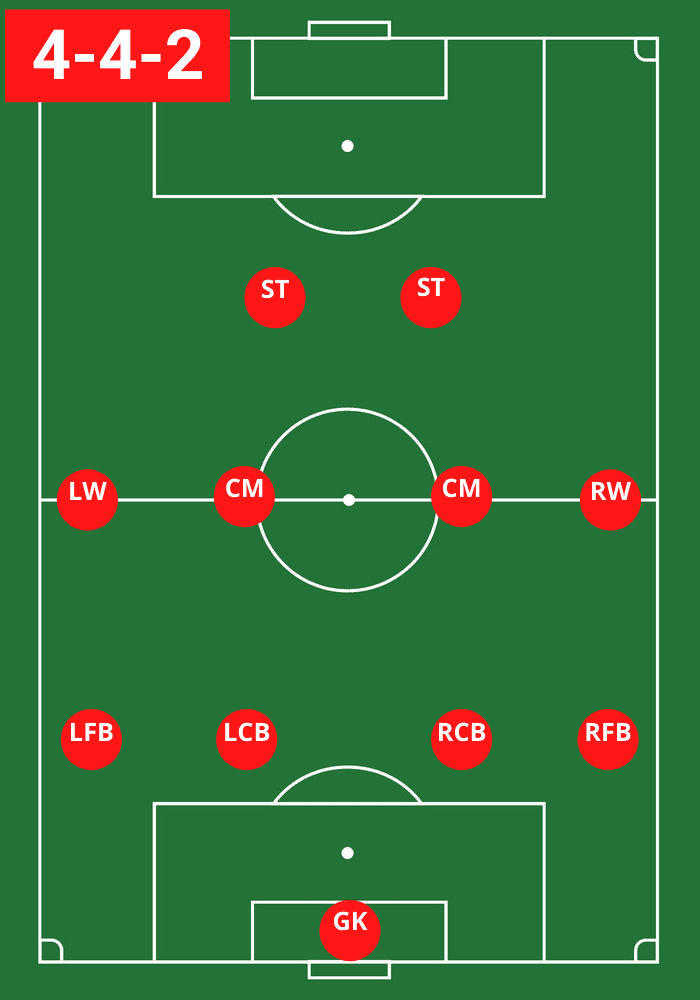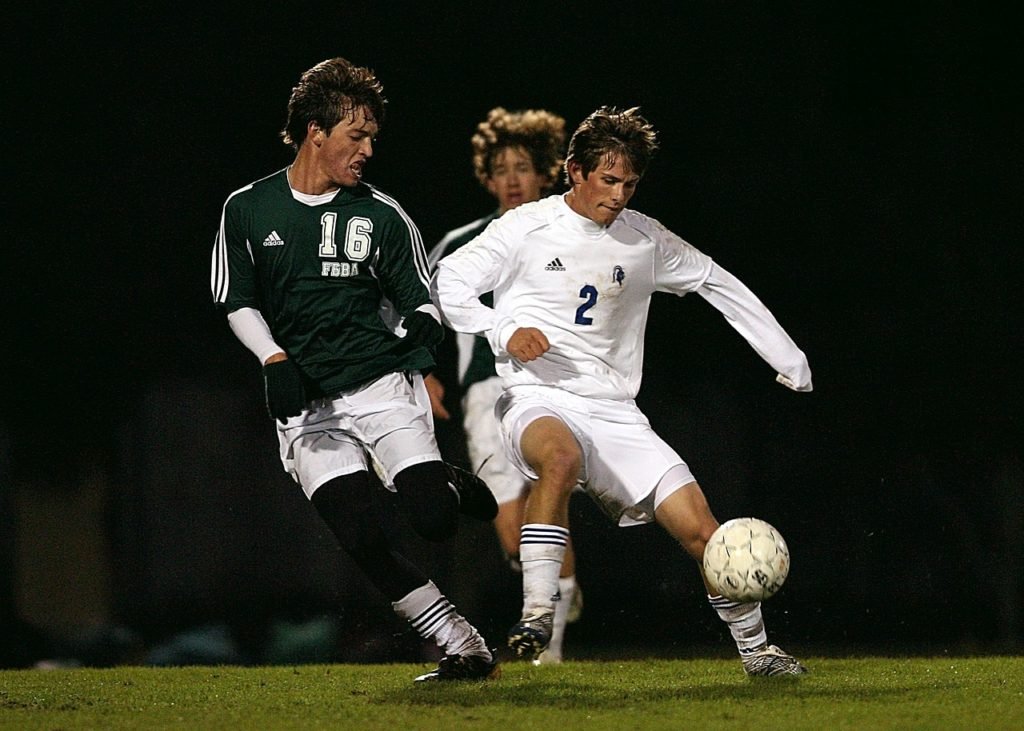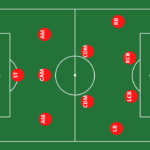Mastering the 4-4-2 Soccer Formation
Tactics and Strategies
- Last Updated -
A Brief Overview of The 4-4-2 Soccer Formation
The 4-4-2 soccer formation is a standard formation consisting of four defenders, four midfielders, and two strikers. The goal of this formation is to maximize offensive attacks while maintaining a solid defensive line. Two central strikers form two banks of four players that the opposing team has to breach to get through on goal.
The formation is considered defensive when used correctly. The midfielders in a 4-4-2 formation reduce the space given to opposing players in the midfield and provide passes to the wingers or strikers whenever an attacking opportunity is available.
The 4-4-2 is the most commonly used formation in soccer and works well whether a team is interested in attacking or defending, based on the situation.
The History of The 4-4-2 Formation
The 4-4-2 soccer formation is one of the most popular formations used in soccer. It has been used since the 1960s and has had different variations throughout history. In the early years, the formation was focused on creating a strong defensive line, but it has since evolved to include more attacking options. The formation gained popularity in the 1990s, and it has been widely used by top teams ever since.
Today, it remains a favorite formation due to its versatility and balance between defense and attack. The formation’s success can be attributed to its clear roles and expectations for each player, making it easier for players to understand their responsibilities on the pitch.

Why The 4-4-2 is A Popular Formation in Modern Soccer
The 4-4-2 formation remains one of the most popular tactics in modern soccer due to its versatility and simplicity. With clear roles for each player, it allows for a balance between defense and attack, making it an effective strategy for teams of all levels and styles of play. The system also provides width and strength in midfield, allowing for effective ball control and distribution.
It is less tactically demanding than other formations, making it easier for players to adapt to and execute. Additionally, the 4-4-2 can easily adapt to different game situations, whether a team is focusing on attacking or defending.

Understanding the 4-4-2 Formation
Breakdown of the formation (defensive, midfield, attacking lines)
The 4-4-2 soccer formation is one of the most popular and widely used formations in the sport. This formation consists of four defenders, four midfielders, and two strikers. The defensive line is made up of two central defenders and two fullbacks who stay close to the goalkeeper to form a compact block.
In the midfield, there are two central midfielders who are responsible for controlling the game’s pace and distribution of the ball, while the wingers support both the defense and attack by providing width and crossing opportunities.
The two strikers are the attacking line responsible for scoring goals and creating chances by combining with each other and the midfielders.

The 4-4-2 formation can also be adapted to a 4-4-1-1 when defending, where one of the strikers drops back to form a second line of midfielders, creating small gaps for the opposition to play penetrative passes through the defensive lines [1]. This formation’s simplicity allows players to understand their roles and expectations clearly, making it less demanding tactically compared to other formations. Despite the 4-4-2 formation’s traditional status, it remains a versatile formation that can be used in both attacking and defensive situations, as demonstrated by top managers such as Sir Alex Ferguson, Diego Simeone, and Sean Dyche [6].

Roles And Responsibilities of Each Position
Starting with the goalkeeper,
the main objective is to prevent the opposition from scoring by stopping the shots on goal. Therefore, they need to be agile, have quick reflexes, and have good handling skills. The goalkeeper is also responsible for organizing and communicating with the defenders in front of them.
Moving on to the defenders
The backline consists of two center-backs and two full-backs. The main responsibility of the center-backs is to prevent the opposition from getting through the central areas of the pitch, while the full-backs focus on defending the wider areas of the field. The center-backs are also responsible for initiating the team’s attacking moves by playing accurate passes to the midfielders.

The midfield consists of two central midfielders,
a left midfielder, and a right midfielder [4]. The central midfielders act as the engine room of the team, responsible for linking the defense and the attack.
Their roles include breaking up opposition attacks, supporting the defenders when necessary, and distributing the ball to the attacking players. The left and right midfielders are responsible for providing width to the team’s attacking play by staying wide and stretching the opposition’s defense.

One critical position in the 4-4-2 formation is the defensive midfielder.
This position is considered to be the key player in the diamond 4-4-2 formation [6]. The defensive midfielder’s primary responsibility is to shield the back four and prevent the opposition from getting through the midfield. They are also responsible for initiating the team’s attacking play by playing short, accurate passes to the attacking players.

Finally, the two strikers complete the formation
Their primary responsibility is to score goals by taking advantage of the chances created by the midfielders. However, they are also responsible for pressing the opposition defenders and preventing them from playing out from the back.

Advantages and disadvantages of the 4-4-2 formation
Advantages:
- Balanced: The 4-4-2 formation is a balanced formation that can provide both defensive and offensive stability. It allows the team to cover the field equally, making it difficult for the opposition to exploit any particular area of the pitch.
- Counter-attack: The 4-4-2 formation is particularly effective in counter-attacking situations. The two forwards can quickly transition from defense to attack, while the midfielders provide support.
- Strong defensively: With four defenders, the 4-4-2 formation is well-suited to defending against opposition attacks. The two central defenders can form a strong defensive partnership, while the full-backs can provide cover and support.
- Wide midfielders: The formation allows for two wide midfielders who can provide width and stretch the opposition’s defense. They can also provide support to the full-backs when defending.
Disadvantages:
- Lack of creativity: The 4-4-2 formation can sometimes lack creativity in midfield. With only four midfielders, there may not be enough players to create chances and control possession.
- Vulnerable in midfield: The 4-4-2 formation can be vulnerable in midfield, especially against teams that play with three central midfielders. The opposition can dominate possession and control the game.
- Isolation of forwards: With only two forwards, they can become isolated and struggle to get involved in the game if the midfield is unable to provide support.
- Requires specific players: The formation requires specific players, especially in midfield. The wide midfielders need to be comfortable in both attacking and defensive roles, while the central midfielders need to be able to control possession and create chances.
It is a balanced formation that is effective in counter-attacking situations and strong defensively. However, it can lack creativity in midfield and be vulnerable against teams with three central midfielders. It also requires specific players, and the forwards can become isolated if the midfield is unable to provide support.
Best Tactics and Strategies 4-4-2 nSoccer Formation
Offensive Tactics
Attacking with the forwards and midfielders:
The 4-4-2 soccer formation is a classic and widely used strategy that allows players to attack in numbers while also keeping enough players back to prevent counter-attacks. The attacking potential of the 4-4-2 formation relies heavily on the forwards and midfielders working together to create scoring opportunities.
In this formation, the two forwards typically play as a partnership, with one playing as a target man to hold the ball up and bring others into play, while the other is the main goal scorer. The midfielders play a crucial role in supporting the forwards by providing service through crosses and through balls.

When attacking, the team should aim to create overloads in the midfield and attacking areas of the field, particularly on the flanks where the wingers can create 2v1 situations against the opposition fullbacks. It is also important for the midfielders to time their runs into the box to support the forwards and provide additional scoring options. Coaches can use drills and tactical instructions to train their team to effectively execute attacking movements and combinations within the 4-4-2 formation [1].
However, it is important to note that the 4-4-2 formation does have its weaknesses, particularly in terms of defensive cover in the midfield, which coaches must address through strategic planning

Offensive Tactics Continued
Overlapping runs with the fullbacks:
When it comes to offensive tactics, overlapping runs with the fullbacks can be an effective way to create scoring opportunities.
In a 4-4-2 formation, the fullbacks are responsible for providing width to the attack and supporting the midfielders and strikers in the attacking third. By making overlapping runs, they can stretch the opposition’s defense, create space for themselves or their teammates, and potentially create scoring chances [2].
To execute this tactic successfully, it’s essential that the fullbacks have good communication with the midfielders and strikers, and time their runs well to avoid being caught out of position defensively. The midfielders should also be aware of the fullbacks’ movement and provide cover if needed [1].
Another important factor is the timing of the runs. Fullbacks should look for opportunities to overlap when the opposing team’s defense is out of position or when the ball is on the opposite side of the field, allowing them to exploit space and catch the defense off guard.

Offensive Tactics Continued
Long balls to the strikers:
To execute this tactic successfully, the midfielders and defenders need to quickly and accurately pass the ball to the strikers, who need to have good ball control skills and be able to outmaneuver the opposition’s defense. Additionally, the midfielders must support the strikers by making forward runs and creating passing options to ensure that the long balls are effective.
However, the 4-4-2 formation is known for its solid defensive structure, which makes it challenging for opponents to break through. Therefore, an effective offensive tactic for this formation is to overload one side of the pitch to draw the opposition’s defense to one side, leaving the other side open for a long ball to the strikers. This can be done by having multiple players make short passes on one side of the pitch before quickly switching the play to the other side where the strikers are waiting.
Overall, the long ball to the strikers can be an effective offensive tactic for the 4-4-2 soccer formation, but it requires good ball control skills, quick passing, and support from the midfielders. Additionally, overloading one side of the pitch to draw the opposition’s defense and create space for the long ball can be a useful strategy to consider.

Defensive Tactics:
Pressing high up the field,
The 4-4-2 soccer formation can be a strong defensive system, but it requires strategic organization and execution. One tactic for defense in this formation is pressing high up the field. Pressing high up the field involves the entire team moving forward quickly to put pressure on the opposing team’s players, preventing them from building up play from the back.
To effectively press high up the field in a 4-4-2 formation, it is important to maintain a compact and narrow shape. The two banks of four, plus the two strikers, should be vertically compact to prevent any collapses within the shape. The two midfielders should play a crucial role in pressing high up the field by closing down the space in front of the opposing team’s defense and intercepting passes.
In addition, it is important to identify and target the weakest defensive player on the opposing team. Once the weakest player has been identified, the strongest attacking player on the team should be put up against them in a 1 v 1 situation. Successful 1 v 1 actions can break the team shape of the 4-4-2, creating dangerous spaces to attack the opposition.

Defensive Tactics Continued
Marking and closing down spaces,
One of the keys to a successful defensive tactic in a 4-4-2 formation is effective marking and closing down of spaces.
To begin with, the 4-4-2 formation is predicated on zonal marking, which allows the defensive team to be more proactive in how they seek to contain the opponent. The symmetry between the two banks of players also allows for easier communication and changes as players can replicate the movement of the person either in front or behind them.
In terms of specific tactics for marking and closing down spaces, coaches can consider adjusting the level of closing down for different players. For example, instructing full-backs to close down less and wide midfielders to close down more can help maintain the shape of the back line while still putting pressure on the opposition.
It is also important to maintain compactness and balance across the entire pitch, which can be achieved through effective communication and a well-organized defensive structure. Additionally, teams can consider deploying a high press, mid-block, or low block depending on the situation to establish cover and limit the opposition’s attacking opportunities

Defensive Tactics Continued
Defending as a unit:
One of the key strengths of the 4-4-2 formation is its defensive solidity, which allows the team to control the game and counterattack effectively. However, to maximize the potential of this formation, it is important to ensure that the team defends as a unit.
One effective defensive tactic for a 4-4-2 formation is to use a zonal marking system. This involves dividing the field into zones and assigning each defender to a specific zone. This tactic allows the defenders to cover the areas that are most vulnerable to attack, while also ensuring that the team remains compact and difficult to break down.
Another effective tactic is to employ a pressing strategy, whereby the team puts pressure on the opposition players as soon as they receive the ball. This tactic can be particularly effective in disrupting the opposition’s attacking play and forcing them to make mistakes.
When defending as a unit, it is important to maintain a good balance between the midfield and defensive lines. The midfielders should work to track back and support the defense when necessary, while the defenders should communicate effectively to ensure that they maintain their defensive shape and cover each other’s positions effectively.

Mastering the 4-4-2 Formation
Team preparation and training strategies
To prepare a team to play in this formation, there are several key strategies that coaches can employ.
- Firstly, it is important to focus on balance in the formation. The 4-4-2 provides both attacking and defensive capabilities, so coaches must ensure that their players are comfortable in both roles. This means that all players must be able to contribute to the attack while also being responsible defensively.
- Another important aspect of training for the 4-4-2 is to work on quick transitions. This formation relies heavily on counterattacks, so teams must be able to quickly transition from defense to offense. This can be achieved through drills that focus on quick passing, movement off the ball, and positioning.
- In terms of individual player roles, fullbacks play an important role in this formation. They must be comfortable moving forward to support the attack while also being able to quickly track back to defend. Coaches should focus on developing their fullbacks’ technical abilities and endurance to ensure they are capable of fulfilling this role effectively.
- Another key position to focus on is the central midfielder. They must be able to control the tempo of the game and distribute the ball effectively. Coaches should work on developing their players’ passing accuracy and decision-making abilities to ensure they can fulfill this role effectively.
- Finally, communication is crucial when playing in the 4-4-2 formation. Players must constantly communicate with each other to ensure they are in the correct positions and to coordinate their movements. Coaches should encourage their players to communicate effectively and provide them with opportunities to practice communication during training [5].
Adapting the formation to fit your team's strengths and weaknesses
- The 4-4-2 soccer formation is a traditional formation that has been used by many teams over the years. However, the success of this formation depends on how well it is adapted to fit the strengths and weaknesses of the team using it. Here are some tips on how to adapt the 4-4-2 formation to fit your team’s strengths and weaknesses.
- One of the key strengths of the 4-4-2 formation is its simplicity. However, this simplicity can also be a weakness if the team lacks certain skill sets. Therefore, it is important to assess your team’s strengths and weaknesses before deciding to use the 4-4-2 formation. For example, if your team has a strong midfield, you may want to consider using a diamond midfield rather than a flat one.
- Another way to adapt to the 4-4-2 formation is by adjusting the roles of your players. For instance, if your team has a strong attacking midfielder, you may want to push them further up the field to support the forwards. Similarly, if your fullbacks are strong attackers, you may want to encourage them to push up the field more to provide additional support to the wingers.
- In addition, the 4-4-2 formation can also be adapted to fit your team’s defensive strengths and weaknesses. For example, if your team lacks pace in defense, you may want to consider playing a deeper defensive line to limit the space behind the opposition’s attackers. Alternatively, if your team has strong defenders, you may want to encourage them to play a higher line to put pressure on the opposition’s attackers.
4 Common Mistakes Made While Playing A 4-4-2 Soccer Formation
like any formation, it is important to avoid certain mistakes when playing it to achieve the best results. Here are some common mistakes to avoid when playing the 4-4-2 soccer formation:
1. Failure to maintain defensive shape:
One of the key features of the 4-4-2 formation is its defensive solidity. To maintain this, coaches must ensure that there are always four defenders positioned across the backline – left back, center backs (two), and right back. Failure to maintain a defensive shape can lead to defensive vulnerabilities, particularly in wide areas of the pitch.
2. Poor communication between goalkeeper and defenders:
In a 4-4-2 formation, the goalkeeper plays a critical role in the team’s defensive organization. The keeper must communicate well with their defense, command the box, and rush out of goal to clear or retrieve the ball if the opposition plays the ball behind the defense to break the offside trap. Poor communication between the goalkeeper and defenders can lead to confusion, misplaced passes, and goals conceded.
3. Lack of positional discipline:
In the 4-4-2 diamond formation, players must maintain tight positions in the middle of the field to control play and recover the ball effectively. Similarly, in the flat 4 approach, four midfielders must line up in front of the backline to create an additional protective wall and maintain defensive solidity. Failure to maintain positional discipline can lead to gaps in the team’s structure and make it easier for the opposition to exploit these gaps.
4. Ineffective use of the two strikers:
The 4-4-2 formation relies heavily on the two strikers to create and score goals. Coaches must ensure that the two strikers have a good understanding of each other’s movements and work together to create chances. Poor coordination between the strikers can lead to a lack of goals and ineffective attacking play.

Frequently Asked Questions
(Question 1.) How does the 4-4-2 formation differ from other formations?
- Firstly, the 4-4-2 formation is simpler than other formations such as the 3-4-3 formation. Every player knows their role in the formation, making it easier to play and less demanding of tactical discipline and knowledge of the game.
- Secondly, the 4-4-2 formation is flexible and can be adjusted to be more attack-minded or defense-minded depending on the situation and players available. The tactics used in the formation also differ depending on whether the team is in or out of possession of the ball.
- Thirdly, the 4-4-2 formation has clearly defined roles for each player, making it easier to defend the entire width of the field when the team is in possession. The formation is divided into three levels of players, with the back level consisting of two center-backs and two full-backs, aligned the same way they are in the 4-3-3 formation.
- Lastly, playing in the 4-4-2 formation requires strategic organization and awareness of individual roles within the team. The formation involves two defensive lines of four players and two attacking midfielders just behind the forwards, playing to support them [5]
(Question 2.) What is the best way to defend against a team playing in a 4-4-2 formation?
- Defending against a team playing in a 4-4-2 soccer formation requires a combination of defensive strategies and tactics. One important strategy is to maintain central compactness, which can be achieved by employing narrow wide players and a shuttling midfield to help maintain horizontal compactness. Defenders must coordinate perfectly and call the offside trap while coordinating with the fullbacks to ensure that midfielders are called back to drop in and defend if a fullback pushes forward.
- Midfielders and strikers must also hassle, harry, and hound the opposition further up the field to force them into mistakes and capitalize on errors to spring a counterattack. One-on-one defending is crucial and players should practice this skill to learn how to defend in soccer.
- In terms of specific tactics, one effective way to break down a 4-4-2 block is to use attacking triangles to pass the ball out of defense and play the ball into corners. Defenders should aim to win possession and quickly form attacking triangles, which are easily formed for teams to pass their way out. Overall, defending against a 4-4-2 formation requires a combination of defensive strategies and tactics, including maintaining central compactness, coordinating perfectly, practicing one-on-one defending, and using attacking triangles to pass the ball out of defense.
(Question 3.) Can the 4-4-2 formation be used in youth soccer?
- Yes, the 4-4-2 soccer formation can be used in youth soccer. In fact, it is one of the most popular formations used in soccer at various levels and divisions due to its versatility and efficiency as an offensive strategy when executed properly. The basic structure and clear roles of the 4-4-2 formation make it easy for players to understand and implement the system on the field, especially when coupled with effective drills. However, it is important to note that this formation has some limitations. The absence of wingers in the formation leads to not enough players for wider play, which can be problematic in both the attacking phase and when defending against teams with side players, leading to a danger of counter-attack. Additionally, a three-man midfield can overwhelm two central midfielders, making passing through the midfield difficult, so the 4-4-2 formation may not be recommended for teams that want to dominate midfield possession. Overall, the 4-4-2 formation can be a viable option for youth soccer teams, but it is important to consider the strengths and weaknesses of the formation when deciding whether to use it.
(Question 4.) Is the 4-4-2 formation outdated in modern soccer?
- The 4-4-2 soccer formation is still used in modern soccer and is considered an effective formation for both offense and defense. The formation is simple, with four defenders, four midfielders, and two forwards, and it allows for flexibility in positioning and team dynamics [1]. Additionally, the 4-4-2 formation is one of the most popular formations used in soccer, with over 40% of teams using it at least once during a season.
- While some critics argue that the 4-4-2 formation is outdated and predictable, coaches and players have adapted the formation to modern soccer by implementing new strategies, such as the diamond formation within the 4-4-2. Moreover, the 4-4-2 formation has the advantage of being easy to understand and implement, making it a popular choice for youth and amateur teams.
- In conclusion, the 4-4-2 formation is not outdated in modern soccer and remains a viable option for teams at all levels. While it may not be the most innovative formation available, it is a flexible and efficient formation that can be adapted to modern soccer strategies.
(Question 5.) How can I get my team to effectively execute the formation?
- To effectively execute the 4-4-2 soccer formation, you need to focus on building strong communication and teamwork among your team members. Encourage team members to share positive and negative feedback so that individuals can improve their skills and recognize areas where they can improve. Take time to walk your team through the formation and answer any questions they have before they get started to ensure they’re set up for success.
- It’s important to invest in training and ensure that each team member understands their role and responsibilities within the formation. As a leader, you should be able to delegate tasks effectively and recognize when someone on the team may need additional support or training.
- Effective communication is essential in any team sport, including soccer. Encourage open and honest communication among your team members, and lead by example by communicating clearly and effectively with your team. Watch your tone when communicating with your team members; how you say something can be just as important as what you say .
- To foster strong teamwork, consider conducting team-building exercises, and make sure to recognize the team’s overall successes. This can increase employee morale and motivation [1]. By inspiring your team to work hard and leading effectively, you can help your team execute the 4-4-2 formation successfully.
4-4-2 Soccer Formation Points to Remember:
Mastering the 4-4-2 soccer formation is essential for both coaches and players to achieve success on the field.
- This formation is popular because of its versatility and efficiency in both offensive and defensive strategies. The structure of the 4-4-2 soccer formation provides a balanced approach to attacking and defending, which allows players to understand their roles and responsibilities with ease, making it a good choice for teams transitioning from smaller formats to 11v11.
- When executed properly, the 4-4-2 formation can also be an effective defensive strategy. The formation creates a wall of two rows of four players, known as the Two Banks of Four, which the opposing team must breach to get through to the goal [3]. The key player in the 4-4-2 diamond formation is the defensive midfielder, who plays a crucial role in maintaining the formation’s shape and balance. [6]
- Coaches and players should experiment with the 4-4-2 formation to find innovative ways to use it to their advantage. There are also variations of the 4-4-2 formation, which can be explored to suit different playing styles and strengths. It is important to note that understanding the 4-4-2 formation and mastering its execution requires careful analysis, practice, and a thorough understanding of the team’s strengths and weaknesses. [5].
What is a cap in soccer?
If you're a soccer fan, you've probably heard the term "cap" being...
Read MoreSoccer vs Football Field – A Tale of Two Fields
Comparing the Corners: Soccer Field Vs Football Field Shapes Let's talk a...
Read MoreBest Indoor Soccer Shoes 2024
Indoor soccer has been gaining popularity over the years, with more and...
Read MoreHandball Rule In Soccer – Law #12
Soccer is one of the most popular sports globally, with millions of...
Read Moresoccer position numbers quick guide
Each player on the field has an important job as it relates...
Read MoreSoccer Substitution Rules: The Strategic Art of Changing the Game
Soccer, known as the beautiful game worldwide, has seen various changes to...
Read MoreDominate the Field With The 4-2-3-1 Soccer Formation
Soccer is a dynamic game that constantly evolves, and its tactics are...
Read MoreSoccer History USA: From Struggles to Successes
Soccer, also known as football, is the world's most popular sport, with...
Read More5-3-2 Soccer Formation: History and Tactics
Are you a soccer enthusiast looking to understand the tactical intricacies that...
Read MoreSoccer Overtime Rules: Everything You Need to Know
Introduction: Overtime Soccer Rules Everything You Need To Know Soccer is a...
Read MoreMastering Soccer Outside Back Position: Tips and Techniques
Soccer is a dynamic sport, and the outside back position is no...
Read MoreThe Mercy Rule In Soccer And The Roll It Plays
Picture this: a soccer match, with one team dominating the field and...
Read MoreSoccer Position Abbreviations – A Beginners Guide
Hey there! You've landed on "Decoding Soccer Positions: A Rookie's Handbook". This...
Read MoreBest Soccer Cleats for Flat Feet 2024
Unlock your soccer potential and tap into the game-changing secret: the ultimate...
Read MoreBest Youth Soccer Cleats for 2024 : Top 5 Pick
Welcome to our comprehensive guide on the best youth soccer cleats for...
Read MoreBox-to-Box Center Midfielder: The Engine of Modern Soccer Teams
Soccer is a game of skill, strategy, and teamwork. Every player has...
Read MoreBest Soccer Cleat Insoles 2024
What are the Best Insoles For Soccer Cleat? Are you a serious...
Read MoreBest Soccer Cleats for Turf 2024
What are the Best Soccer Cleats for Turf Fields? Look no further...
Read MoreSoccer’s Attacking Midfielder And The Crucial Role It Plays
The attacking midfielder position in soccer is a vital role that requires...
Read MoreBreaking Down the False 9 Soccer Position
The false 9 position is a term used in soccer to describe...
Read More


















